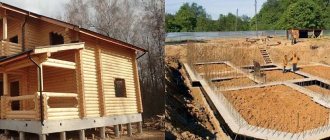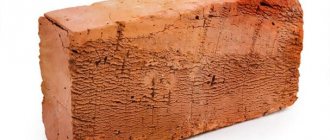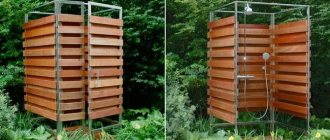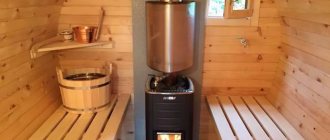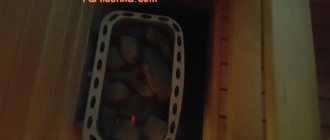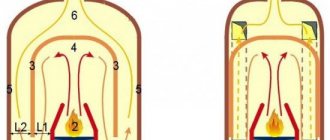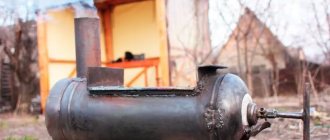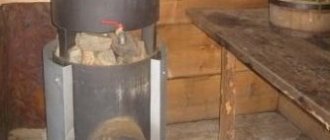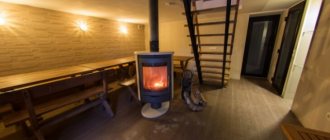In modern country life, a bathhouse is an important component of a harmonious existence and careful attitude towards one’s health. The opportunity to steam in your own sauna is a pleasure that is difficult to refuse, and which depends entirely on the stove.
Already a thousand years ago, different peoples had differences between baths and methods of taking bath procedures. Several centuries ago, the most common Russian bathhouse was a black-style bathhouse (kurnaya), made of stone or clay. Brick was an expensive material back then - it was made by hand and was affordable only by very wealthy people. Massive brick sauna stoves began to appear with the development of industrial methods of production (and cheaper) of this material.
The heater stove is the heart of the Russian bath Source fr.aviarydecor.com
Sauna stoves: features and characteristics
The bathhouse helps to get rid of negative emotions and is often associated with healthy relaxation, good spirits and a cozy atmosphere. The stove is the heart of the sauna; Comfort, steam quality and safety depend on its characteristics. Choosing the main bath attribute is not so easy; there are too many selection criteria and requirements for it. And if the owner decides to build a bathhouse, he will have to deal with several issues: decide on the material and design of the stove, consider its size and type of fuel.
Today, few people other than professional stove makers know that the method of construction and the principle of operation of a sauna stove differs from the functioning of the stove on which food is prepared. The brick sauna stove is a continuation of the traditions of our ancestors, having the following features:
- Construction . The main parts are: a firebox, a chimney, a grate (a place for fuel) and an ash pan (a chamber where ash accumulates).
Sauna stove with original design Source pinterest.com
- Characteristic . Kamenka, a container for stones, which can be closed or open. The stones are used as a heat accumulator, increasing the time of bathing procedures.
- Weight . Can reach 1000-1200 kg (depending on the size of the stove). For such a massive structure, a reliable foundation is built.
- Fuel . Firewood is used for the firebox, but the stove can operate on both electricity and gas.
Brick sauna stoves are determined by two main parameters:
- Dimensions . The size depends on the area of the premises that are planned to be heated. Most often, there are stoves with a base area of 3.5x4 bricks (890x1020 mm) or 4x5 bricks (1020x1290 mm). If you do not take into account the chimney pipe, the height of the structure is 1680 mm (or 2100 mm if the steam room ceiling is high).
- Construction . Owners prefer to install a model with a water circuit, which serves as a tank for heating water. The tank can have an upper (next to the chimney) or lower (near the firebox) location.
The heater was left in the steam room, the firebox was moved to the dressing room Source sdelaikamin.ru
Pouring the foundation
The foundation is the basis of the entire building. There are increased demands placed on him. The foundation must be strong and reliable, capable of supporting the heavy weight of the building.
The construction of the foundation is carried out according to the scheme.
- Dimensions are applied to the base. Pegs are driven into the corners, and a thread is pulled over the stakes for ease of orientation. The size of the markings corresponds to the dimensions of the oven.
- Prepare the pit. Depth – 60-70 centimeters, the lower part is additionally expanded by 10 centimeters to the sides. The shape of the pit should be trapezoidal.
- A layer of sand 5-10 centimeters thick is poured onto the bottom. Broken brick or crushed stone is poured on top. Sand is also sprinkled on top. The thickness of the puff pastry is approximately 25-30 centimeters.
- Waterproofing is laid on top of the compacted brick with sand. Traditionally, roofing felt is used.
- Formwork is installed around the perimeter of the pit. A reinforcing mesh is installed in the pit itself.
- The formwork is poured with concrete. In this case, 10-15 centimeters are left to the top. They are necessary for leveling the surface and laying the base layer of bricks.
The foundation is allowed to settle and set. This period takes from 5 to 7 days, after which the formwork is removed. The voids are filled with gravel. Roofing felt is laid on top of the foundation. It is recommended to do waterproofing in two layers for reliable protection against groundwater leakage.
Advantages and disadvantages of a brick kiln
No matter how profitable and easy to use metal stoves are, owners with worldly experience prefer proven brick structures. A brick sauna stove has the following advantages:
- Heat capacity . The stove is capable of retaining heat for 6-8 hours and heating several rooms (depending on location).
- Energy independence . A wood-burning stove is an ideal option if there is no gas supply and there are power outages.
- Savings during operation . There is no need to install a gas pipe or run wiring and then pay bills. Firewood will cost much less (especially if you prepare it yourself).
- Comfort . Such stoves produce rich, but not scalding (light) steam and soft heat. The atmosphere of the steam room does not make breathing difficult and is ideal for those who like to steam frequently and tastefully.
Compact brick structure Source tproekt.com
- Environmental friendliness . Both the brick from which the stove is made and the firewood are environmentally friendly materials that are safe for health.
- Design . There are real masterpieces of stove art with stunning architecture and design.
- Fire safety . Provided with design features that fully comply with SP 7.13130-2013.
Brick kilns are inferior to other designs due to disadvantages:
- Difficulties in execution . The masonry process has nuances, and it is not easy to find a competent stove maker.
- Size . A large stove eats up precious steam room space.
- Price . The pleasure of making bricks is not cheap: you need to build a foundation, purchase high-quality bricks and pay for the services of a craftsman.
- Time . The stove heats up, and the steam room takes a long time to heat up.
- Care . Systematic cleaning of the ash pan and periodic cleaning of the chimney are required.
A brick stove emits soft heat that is as comfortable as possible for a person. Source tutknow.ru
See also: Catalog of companies that specialize in the installation of fireplaces and stoves.
Project security
A brick sauna stove needs proper insulation from wooden surfaces - a rule, the violation of which sometimes ends in a fire. For bath procedures to be safe, several conditions must be met:
- Foundation . A reliable foundation is needed, which is arranged according to certain rules.
- Chimney . The pipe passes through the ceiling, ceiling elements and roof. When installing a chimney, it is necessary not only to protect adjacent surfaces from heat, but also to maintain the tightness of the steam room. The pipe is separated from all elements of the building by a gap filled with a layer of fire-resistant material.
- Furnace location . The general rule is that wooden walls should be protected from heat. Therefore, there are minimum permitted distances: between the side surfaces of the stove and the walls - 50 cm, between the combustion door and the opposite wall - 150 cm.
- Isolation . The wall behind the stove is protected by brickwork and metal sheets. A metal sheet (10 mm thick) is placed on the floor in front of the firebox as a protective measure against embers flying out of the flame.
The floor in front of the firebox is insulated with a layer of brick Source kvartal-club.com.ua
Materials for the stove: what and how much
Bricks that can withstand repeated temperature changes are suitable for masonry. There are two fairly strong, fire-resistant bricks:
- Fireclay brick . Heat-resistant material of a creamy-yellowish color that can withstand heating up to 1400°C without loss of strength. Such a brick accumulates heat without harm to itself and at the same time has high thermal inertia (slowly heats up and cools down). The parameters are superior to other varieties, but they are also more expensive, which is why they are used mainly for laying out the firebox (20-30 pieces are required).
- Solid red brick marked M (not less than M150). The body, chimney and decorative elements are laid out of it. For a modest structure, 250-280 bricks may be enough; for a large project, 800 (or even 1000) ceramic bricks will be needed.
This fireclay brick will withstand application temperatures up to 1350°C (marking ШБ) Source nsk.zoon.ru
In addition to brick, other materials and tools will be needed:
- Masonry mortar . Consists only of clay and sand. It does not use cement, which crumbles when heated and causes destruction of the masonry over time.
- Furnace casting . Cast iron doors, steel containers for water and stones, a grate (grid), and a view (oven damper) are used.
- Thermal insulator . Any material that can withstand temperatures up to 1200°C is suitable - for example, basalt wool in thin sheets.
- Tools . You will need trowels, a tape measure and a building level.
Kamenka - a feature of the stove for a Russian bath
The main attribute of a bathhouse is often classified according to the heating method:
- The first to appear were stoves that were heated black . They did not have a chimney, and while the logs were burning, the smoke accumulated in the room and stained the walls with soot. Afterwards, the smoke was released through the window, and in order to take a steam bath, you had to wait until the firewood burned completely. Heat and steam were obtained from heated stones lying in the hearth, a prototype of the heater.
- Stoves that burn gray or white have a chimney and a heater in their design. A gray sauna (with an open heater) warms up faster, but soot also accumulates on the stones, and this means that you have to wait until the wood burns out completely.
- In the white sauna, the stove is equipped with a closed heater. It does not pollute the walls of the steam room, does not burn oxygen and carefully preserves heat for a long time. If the steam coming out of an open heater is hard and scalding, here it remains comfortable and soft, even if the thermometer shows 100°C.
Black-style bathhouse, with an open heater Source pechnoy.guru
See also: Catalog of bathhouse projects presented at the “Low-Rise Country” exhibition.
In addition to bricks, other materials and tools will be needed:
- Masonry mortar . Consists only of clay and sand. It does not use cement, which crumbles when heated and causes destruction of the masonry over time.
- Furnace casting . Cast iron doors, steel containers for water and stones, a grate (grid), and a view (oven damper) are used.
- Thermal insulator . Any material that can withstand temperatures up to 1200°C is suitable - for example, basalt wool in thin sheets.
- Tools . You will need trowels, a tape measure and a building level.
Frequently asked questions
Users choosing a wood-burning stove for a sauna often have the same questions. These can be answered in advance so that people don’t have to waste time thinking:
What is better, a stove with or without a water tank?
It is always recommended to prefer stoves with a water tank - they do not increase the cost too much and have virtually no effect on fuel consumption, but they provide a lot of additional options.
Do you need extra power for a wood stove?
Necessary and even necessary. The efficiency of a wood-burning stove is not infinite; in winter frosts, without a power reserve, you will have to warm up the bathhouse for too long, which means high fuel consumption. It is much easier to slightly reduce the supply of firewood, but be able to increase heat transfer.
Which model is better to choose, domestic or imported?
Most imported stoves are much more expensive than domestic ones. However, price should not be the main determining factor. First of all, we need to consider the technical characteristics, especially the firebox material.
What size water tank is best?
A large tank will require a long time to warm up the water. Therefore, it is customary to be guided by the following criteria - for one person you need to install a capacity of 50 liters, and for a company of several people - twice as much.
Which furnaces require a separate foundation?
According to SNiP, a separate foundation is required for stoves weighing over 700 kg. If the base for the bathhouse is a monolithic slab, a separate foundation for the stove is not required. It is necessary to take into account that for structures whose weight approaches the maximum, it is better to immediately build a separate support system.
When choosing a wood-burning stove, you need to take into account the size of the bathhouse, the size of the interior, the type of foundation and other features. There are domestic and imported models on sale. They differ little in performance indicators, except for the price - foreign analogues are more expensive.
In addition to the main qualities, you should consider the presence of additional functions (for example, a water tank), take into account the size of the heater and other features. This will help you choose the most successful model. If brick structures are preferred, you will have to allocate time to build and shrink the stove. At the same time, its ability to heat the room will be significantly higher than that of metal ready-made models.
Kamenka - a feature of the stove for a Russian bath
The main attribute of a bathhouse is often classified according to the heating method:
- The first to appear were stoves that were heated black . They did not have a chimney, and while the logs were burning, the smoke accumulated in the room and stained the walls with soot. Afterwards, the smoke was released through the window, and in order to take a steam bath, you had to wait until the firewood burned completely. Heat and steam were obtained from heated stones lying in the hearth, a prototype of the heater.
- Stoves that burn gray or white have a chimney and a heater in their design. A gray sauna (with an open heater) warms up faster, but soot also accumulates on the stones, and this means that you have to wait until the wood burns out completely.
- In the white sauna, the stove is equipped with a closed heater. It does not pollute the walls of the steam room, does not burn oxygen and carefully preserves heat for a long time. If the steam coming out of an open heater is hard and scalding, here it remains comfortable and soft, even if the thermometer shows 100°C.
Black sauna, with an open heater Source pechnoy.guru
It is convenient to divide sauna stoves according to the heating method:
- Periodic action . Here the stones are on the grate above the flame and have maximum contact with it. Water can only be poured onto the stones after the wood has burned out (otherwise you risk dousing the fire). The stove has to be lit periodically.
- Constant (continuous) action . The stones are in a closed heater (an insulated metal container), which is heated by fire. Heat transfer suffers a little, but you can pour water and heat all the time (constantly), and the soot remains inside and does not pollute the steam room. The stove is lit when there are people in the room; its design prevents combustion products from entering the steam room.
The design of the stove is responsible for generating that famous “light steam”, optimal temperature (70°C) and humidity (60%). Stoves with a closed (internal) heater cope best with this task.
Necessary Requirements
A simple brick stove for a bathhouse is quite suitable. However, the structure must meet a number of specific requirements. The drawing of a brick oven is made taking into account the total area of the room. The structure must be folded according to all the rules. Such a stove should behave the same at -20 and +20 degrees. Thus, during the summer, the brick oven should be heated first. Only then comes the turn of the room itself. If poorly heated stones come into contact with a heated room, heavy damp steam will form. It, in turn, does not have any healing effect, but only harms.
Video description
About the stove with a water tank in the following video:
Of course, a stove with a pile of stones on top looks much more impressive and produces excellent steam. In fact, an open heater is more suitable for a Finnish sauna, with its high temperature and dry air (Finns pour little water). High temperatures and high humidity can cause heart problems in an unprepared person. The main benefit of an open heater (as well as a metal stove) is the rapid heating of the room.
Construction of a brick sauna stove: sequence of work
Each brick sauna stove is a piece production product. Regardless of which configuration is chosen, the stove is built according to the established order, from the foundation to the chimney and finishing. The main task is to ensure that it does not smoke and effectively heats the steam room.
Planning
The stove design (size and configuration features) is selected in advance, simultaneously with the preparation of the bathhouse design. After choosing a project, an order is drawn up - a plan that shows the layout of bricks separately for each layer (row).
An example of the arrangement (diagram) of a brick oven with a bottom placement of the water tank Source banya-expert.com
Preparation of the drawing
The most important stage for the construction of a high-quality stove in a bathhouse is the preparation of a plan diagram, which should display:
- Design dimensions.
- Type of selected model.
- The location of the firebox and the exit for storing firewood.
- Location and dimensions of the chimney.
- Details of the compartment for stones.
All parameters must be thought out in advance and then transferred to paper. During work, it is worth periodically reviewing the drawings, coordinating your actions.
If you wish, you can always use the services of a professional builder who will draw up the optimal drawing. Before starting work, it is also better to watch several video lessons on how to correctly draw up a high-quality drawing.
Video description
About the detailed process of laying a heater in the following video:
Masonry
When the clay mortar is ready, start laying. It is recommended to start with the construction of a brick wall that protects the adjacent wall from critical heating. The laying of bath stoves is carried out in compliance with the following rules:
- Before starting work, stock up on a printed order .
- The bricks are laid according to plan ; Castings are inserted as needed.
- Experienced stove makers prefer to lay each row first “dry” , without mortar. This preliminary fitting significantly improves the process and allows you to avoid difficult mistakes. The method makes it possible to accurately select bricks and try on castings.
- Formation of the first row . An important stage on which the geometry of the furnace depends. At the end of the row, check the corners.
- Laying out the body . The second row (and subsequent ones) are laid offset so that each seam falls in the middle of the brick from the previous row. This staggered arrangement ensures the reliability of the design.
Fireclay bricks are used for laying the firebox Source tproekt.com
Conclusion
Heater in the steam room - both spirit and temperature
Currently, a large number of methods for heating a bath are offered, but only a stone stove lasts longer and brings more benefits. Our portal offers you additional information on this topic, and the video in this article will examine in detail all the nuances that we discussed in this material.
Did you like the article? Subscribe to our Yandex.Zen channel
About Kuznetsov's sauna stove
The team led by Igor Viktorovich Kuznetsov developed a fundamentally new design of a furnace with a two-tier bell - a chamber in which heating occurs (in the lower bell) and separation of the movement of hot and cold gases (in the upper bell). Hot gases are retained in the furnace, which significantly increases the heat transfer of the structure.
Kuznetsov’s brick stove can maintain a suitable temperature not only in the steam room, but also in the washing room and in the rest room. High efficiency, economical fuel consumption and a minimal amount of soot during combustion contribute to the popularity of the design.
Fragment of brick oven masonry Source bazar.bg
comparison table
| Type of oven | Heat | Cooling down | Fuel consumption | Price |
| Cast iron | 30-40 minutes | 30-40 minutes | 4.4 kg/h | from 15 thousand rubles |
| Steel | 15-20 minutes | 10-15 minutes | 6-7 kg/h | from 16 thousand rubles |
| Electric | 10-15 minutes | 15-20 minutes | 3-6 kg/h | from 25 thousand rubles |
| Brick | 2-3 hours | 10-15 hours | 6-9 kg/h | from 15 thousand rubles |
Brick oven: cladding features
Brick stoves are suitable for cladding like no other, since brick and cladding have approximately the same coefficient of thermal expansion, which cannot be said about a metal structure. The brick oven heats up gradually, and the lining has time to warm up evenly. The most popular facing materials are:
- Clinker tiles . Clinker is characterized by high refractoriness and heat capacity; it does not deform over time and gives a cozy appearance to the steam room. During production, dyes and fireclay clay are mixed into clinker.
- Terracotta . Pressed unglazed clay that has been fired. The tile has a characteristic red-brown color and excellent strength indicators.
The fashion for tiles spread in the 17th and 18th centuries and has remained in demand to this day Source forumhouse.ru
- Majolica . Tile material obtained by pressing; an improved version of terracotta. A colored design is applied to the tiles and covered with glaze.
- Tile (a type of tile). Special box-shaped tiles, often handmade, decorated with a sophisticated pattern and filled with glaze, were originally invented for lining stoves. The tiles have a special design on the back side and are fastened with special metal pins into the seams, simultaneously with the stove masonry.

